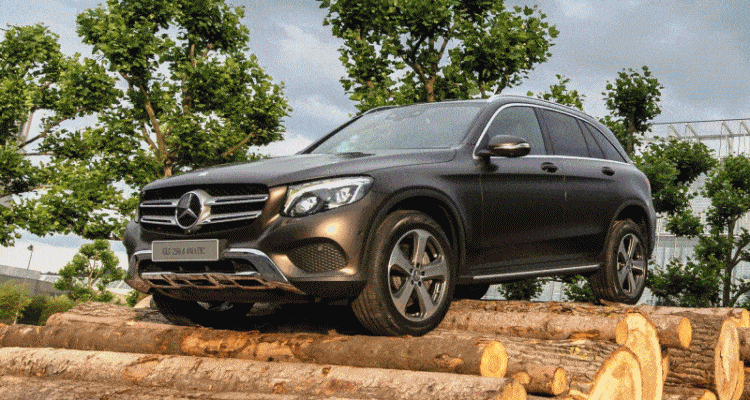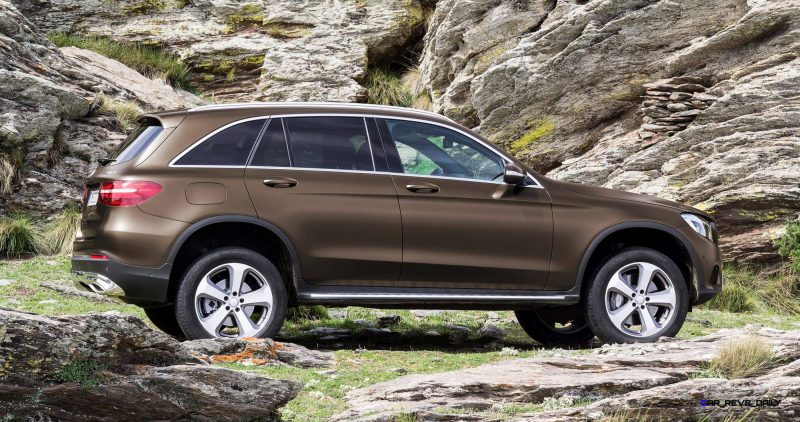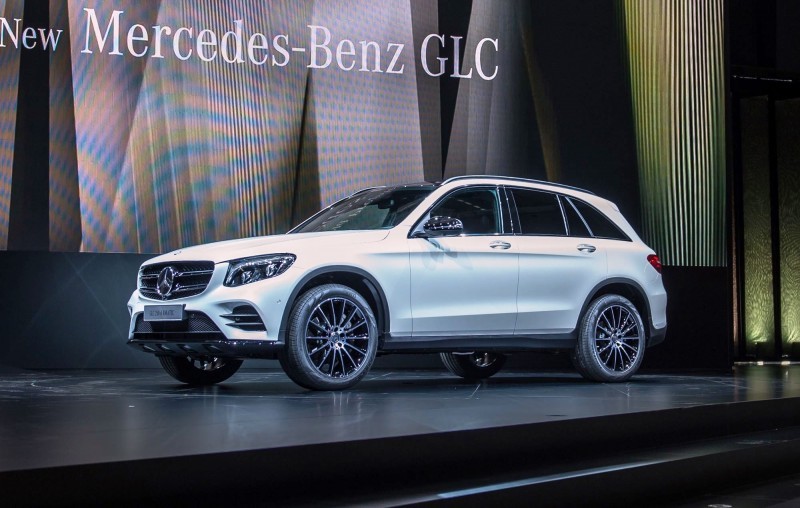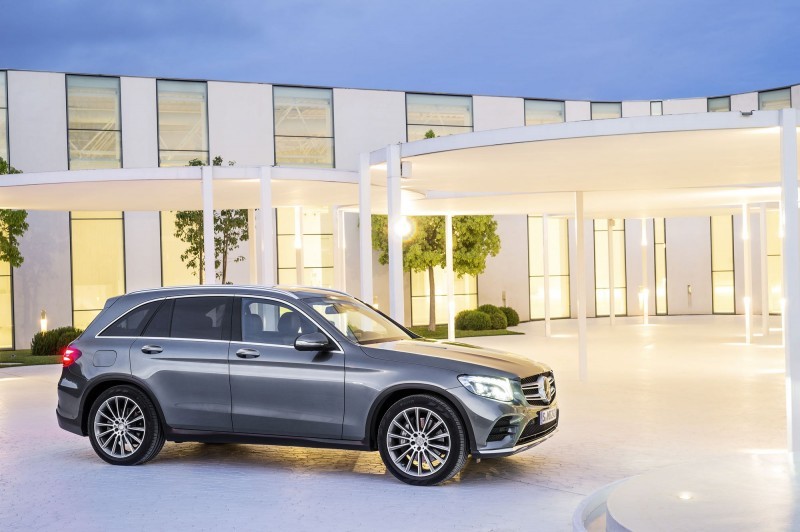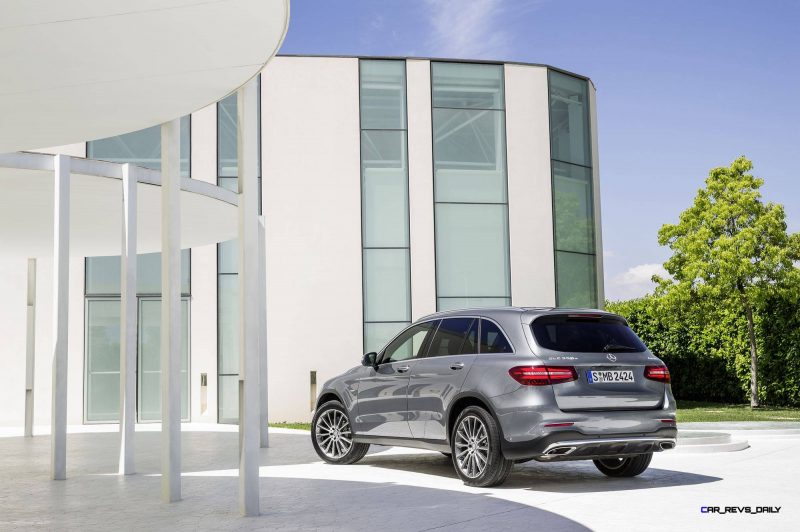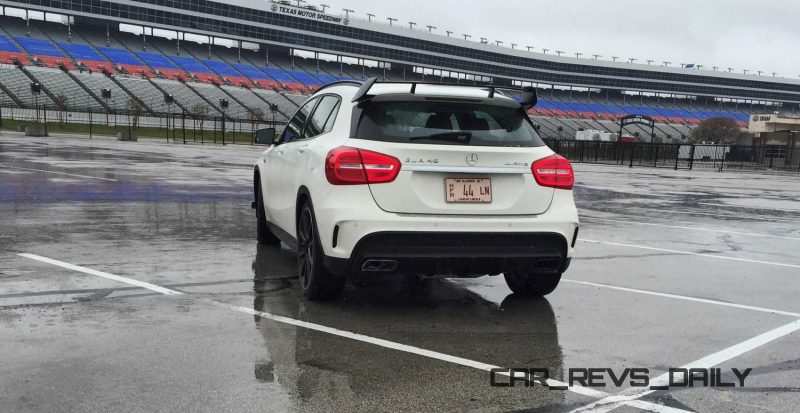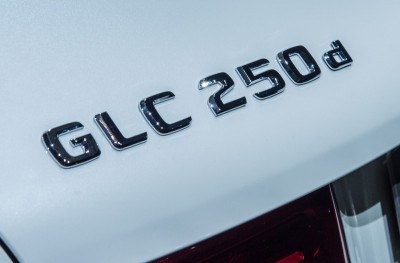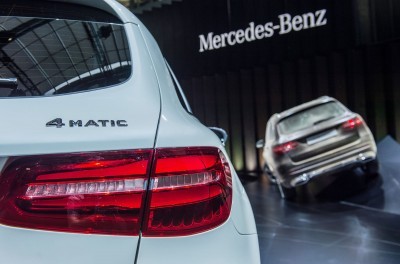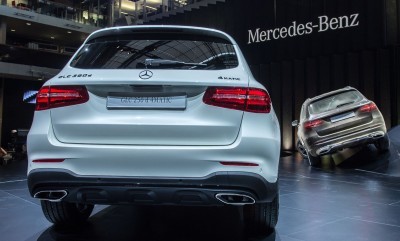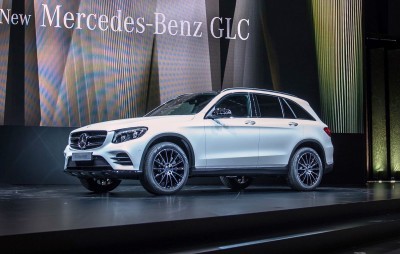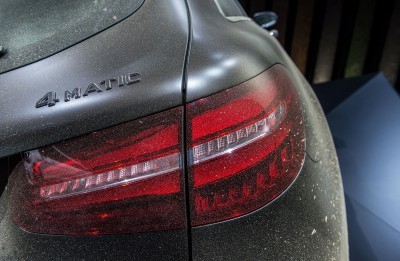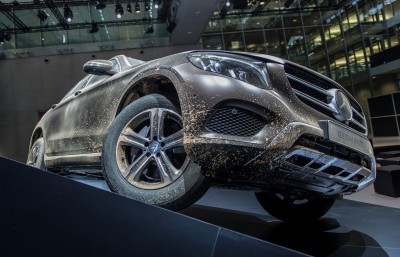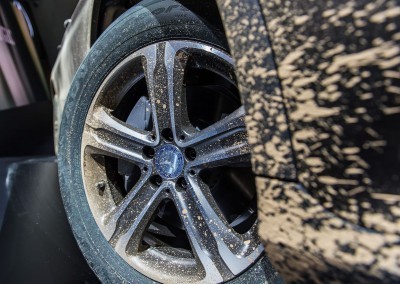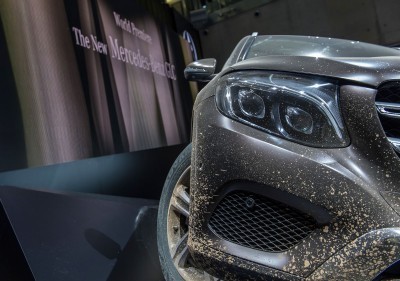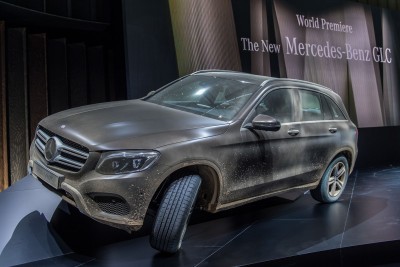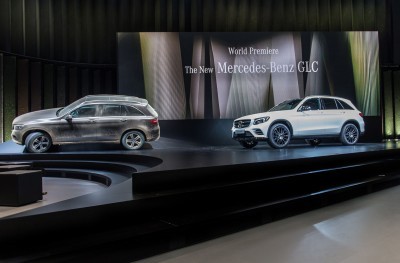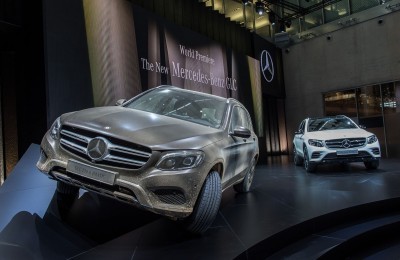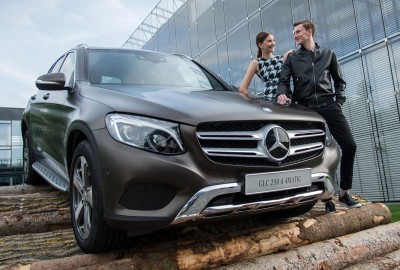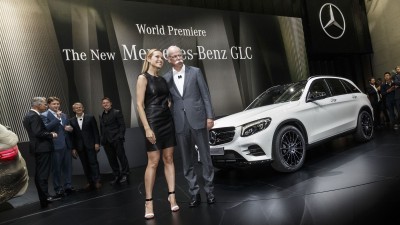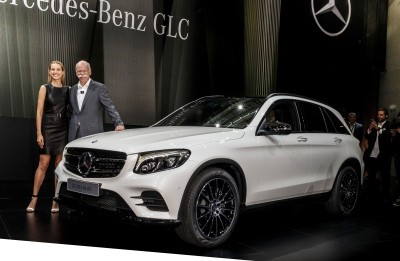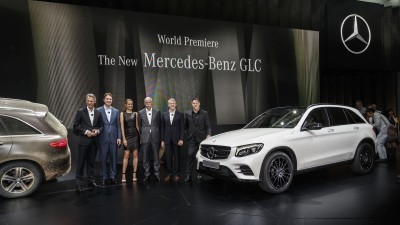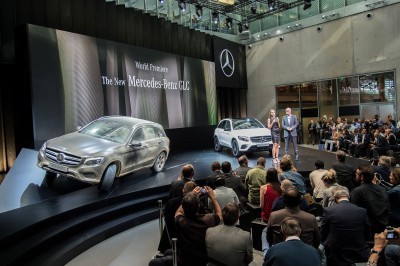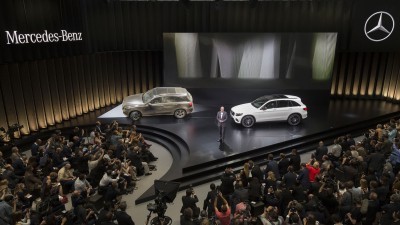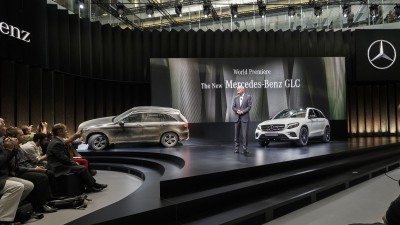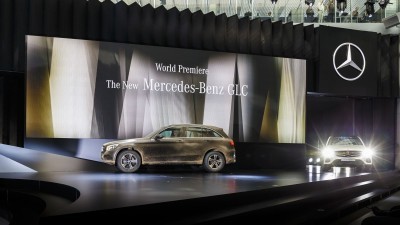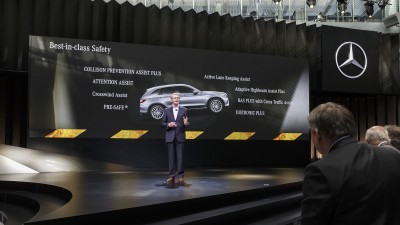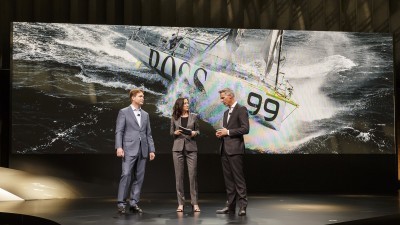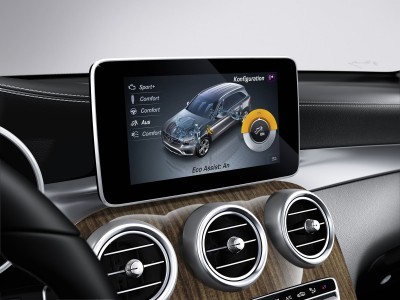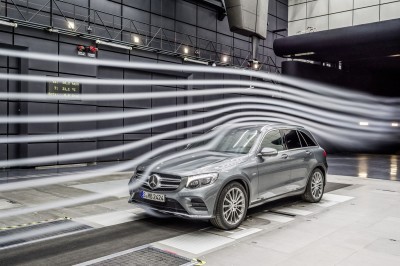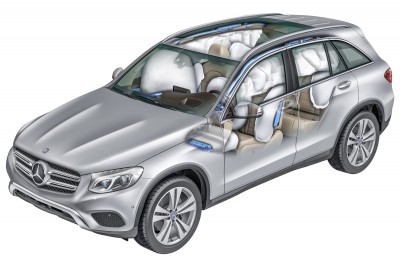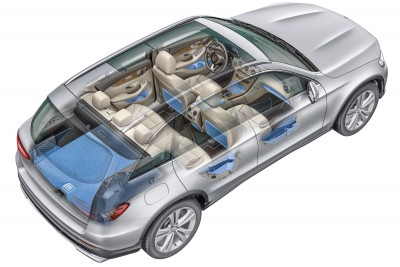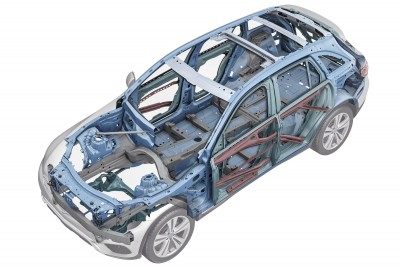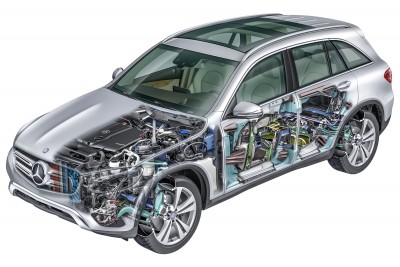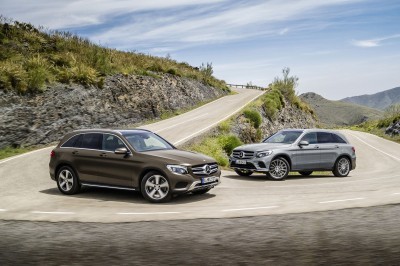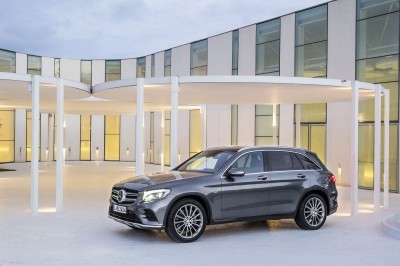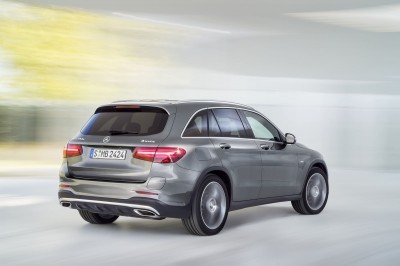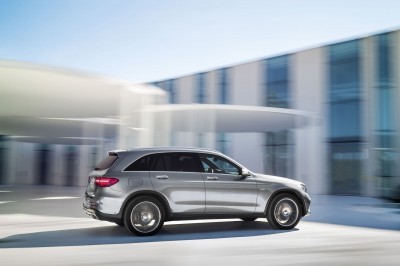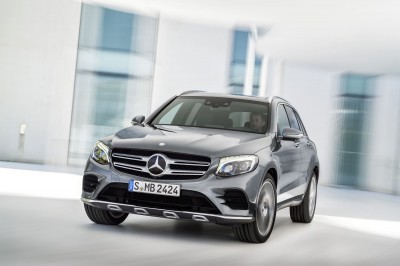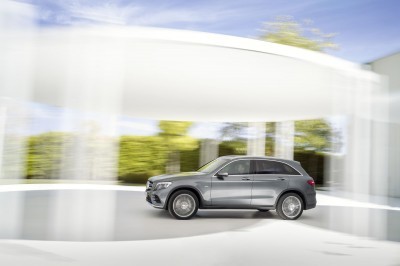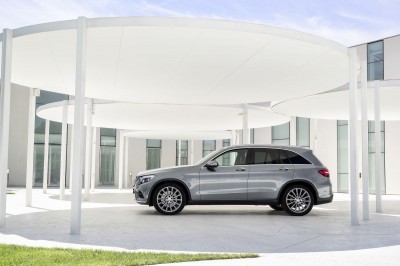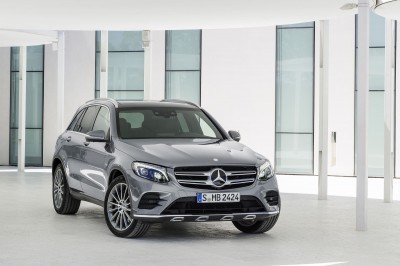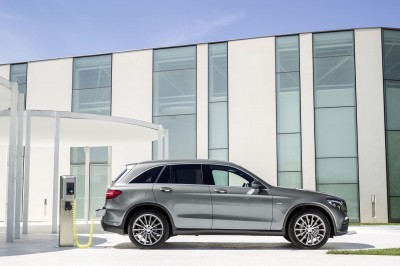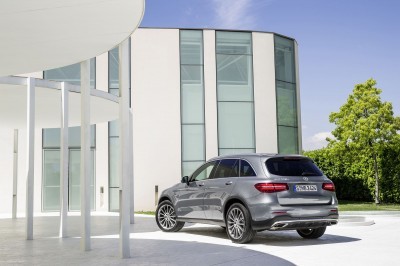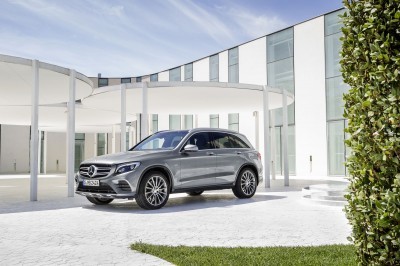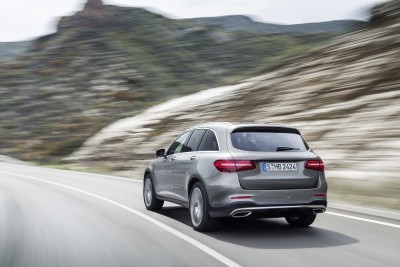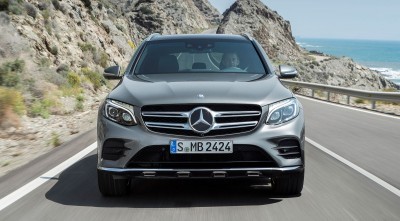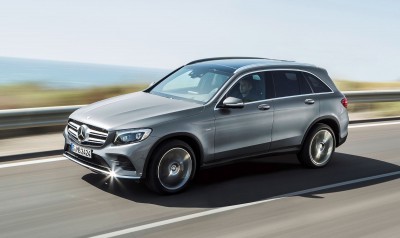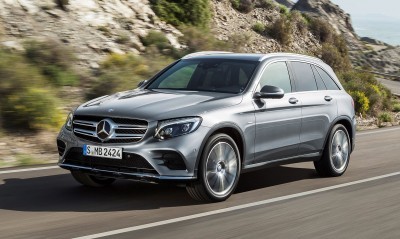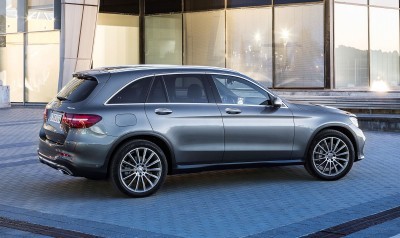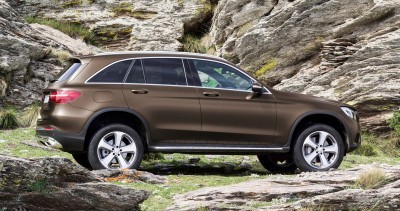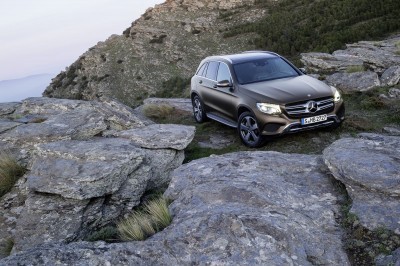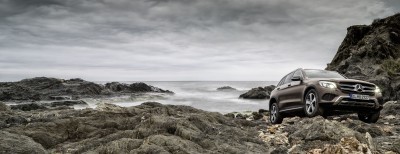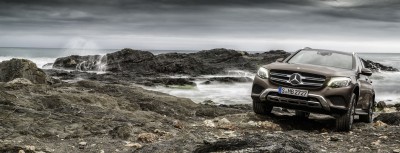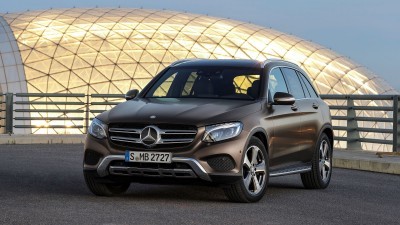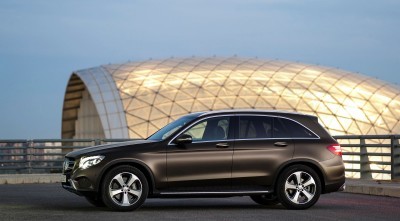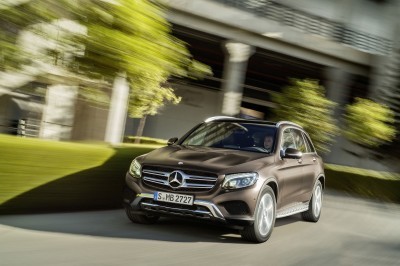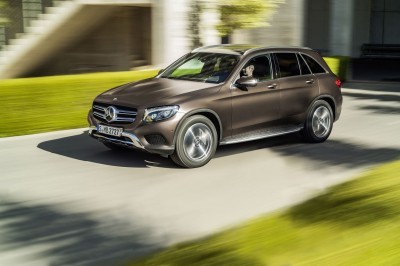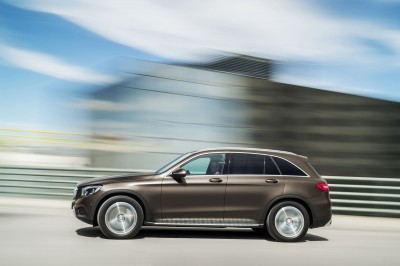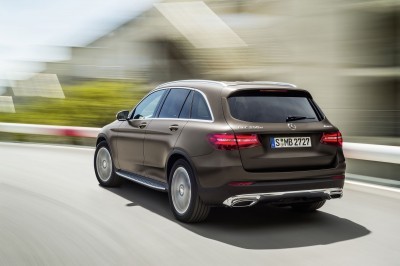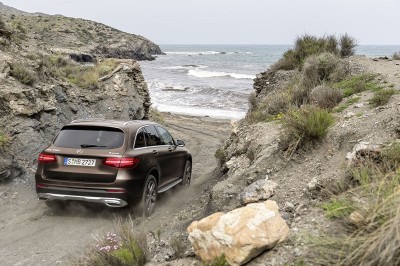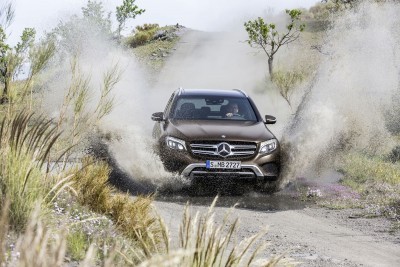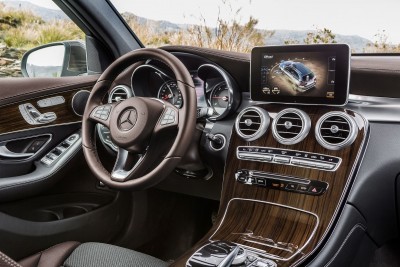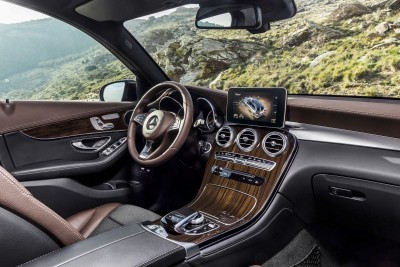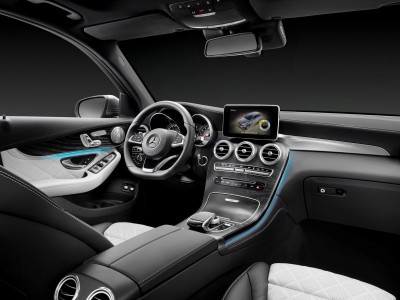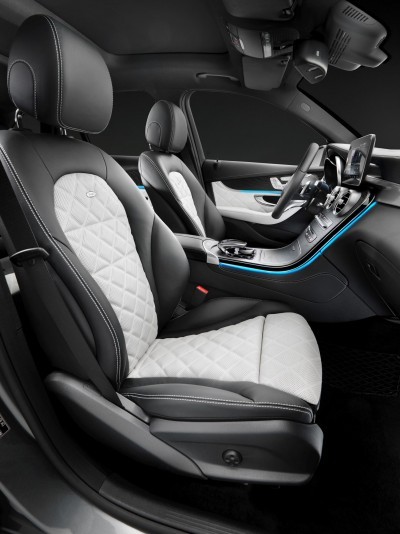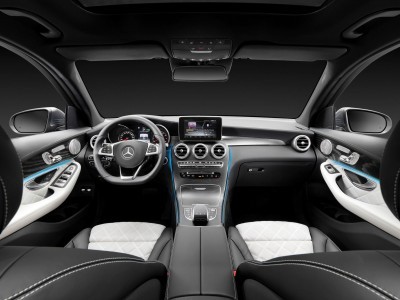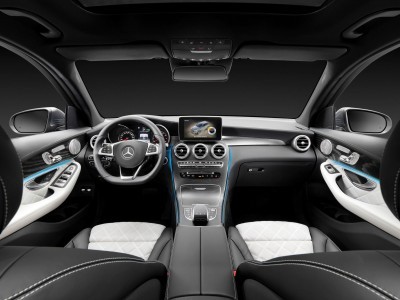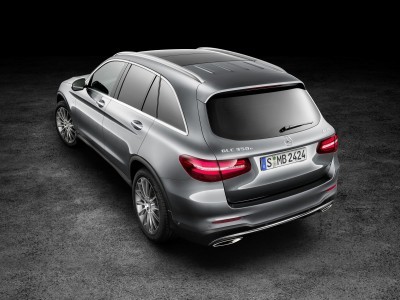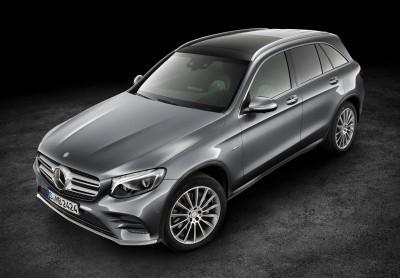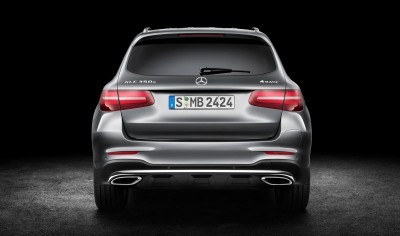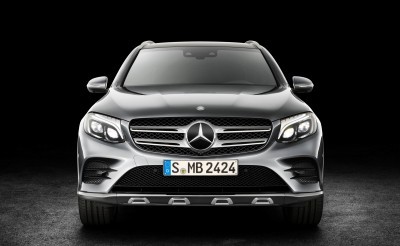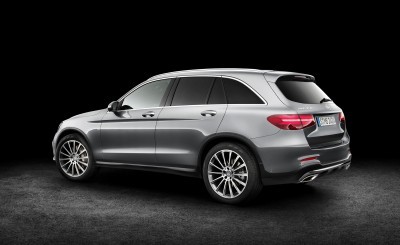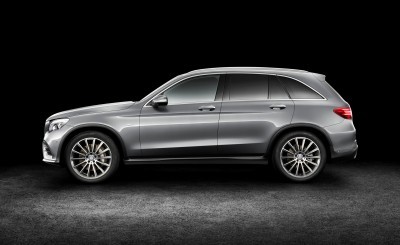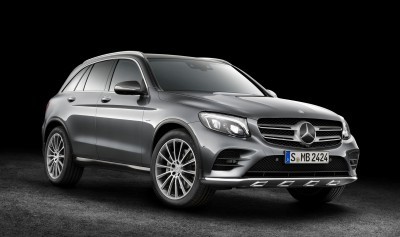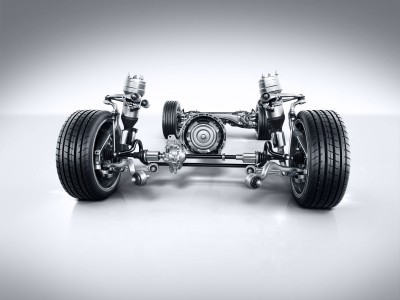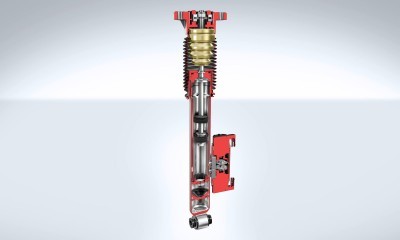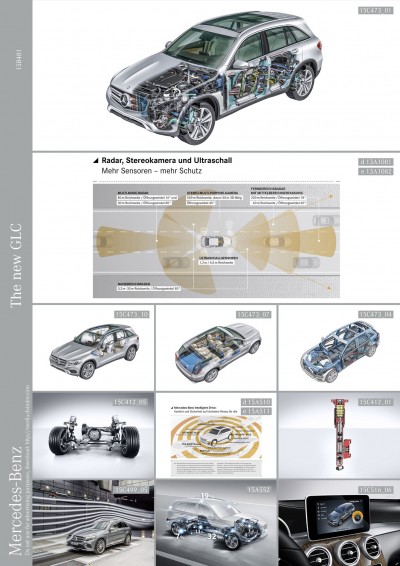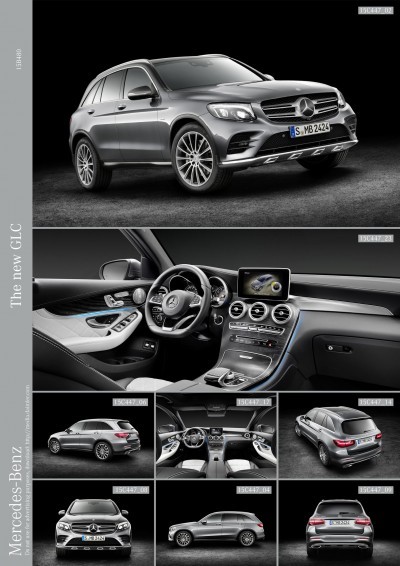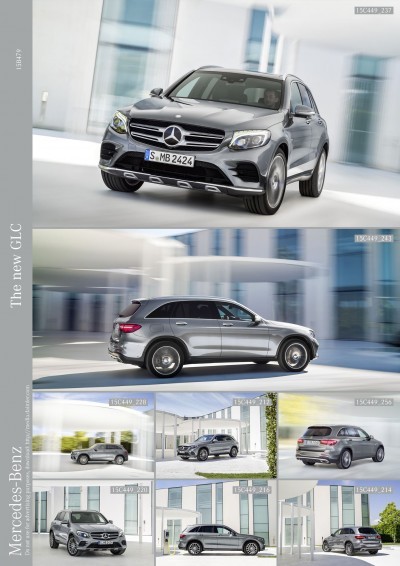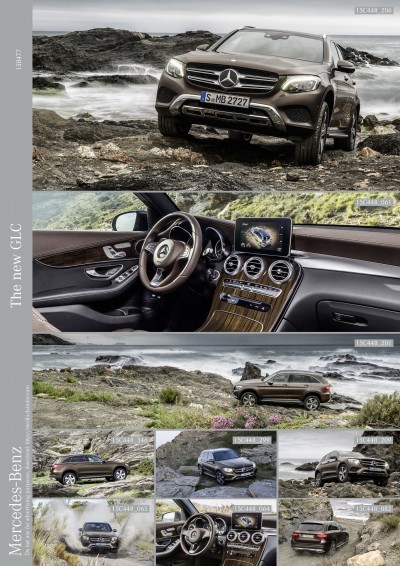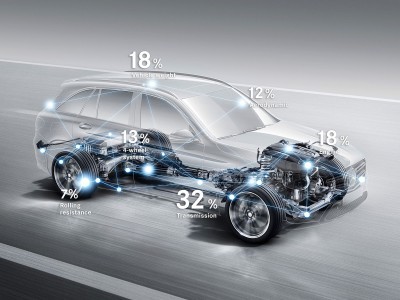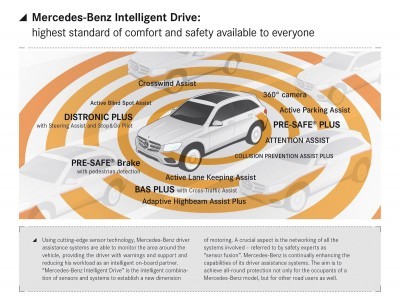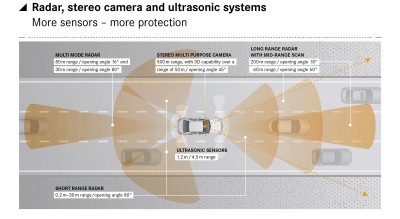The Mercedes-Benz SUV blitz is in full swing — after the GLE and GLE Coupe twins, the latest family member has finally broken cover: the 2016 GLC.
Renamed to align with the E-Class and C-Class in overall size and tech, the latest Merc SUV range is now far broader and able to scoop up sales that might have been lost to the BMW X3, Porsche Macan and Land Rover Discovery Sport.
The GLC is a drastic departure from the boxy and off-road-oriented design of the GLK. This new truck focuses on practical and aesthetic improvements across the board. Added power and lower roof will help the GLC to become an agile handler with potent sprint times. Air suspension from the C-Class will smooth out any bumps to keep the ride serene inside a fabulous new cabin. A side benefit of the air springs? The GLC is able to stand on its tippy-toes for off-roading through trails even tougher than the GLK could manage before.
The wide new center console creates a dramatic SUV mood with trim-specific silvers and woods, with all the latest active safety and infotainment tech missing from the old GLK.
The GLC’s lux appeal drops the upright seating angles and windshield lines of the GLK in favor of a fresh crossover style with sleekness at its core. A strong rear-drive stance and long hood is far more premium than the mini GLA250 at the bottom of the range, while premium and LED lighting sweeps the nose and tail in a fantastic way. Up front, the LED signature closely mirrors the C-Class, but the tail shows a slimline set of horizontal lights that are far sexier than the red blobs that mar the trunk of the GLA. 
Multiple powertrains are expected globally and in the US market, with the launch model of the GLC300 likely to arrive around December of 2015 as a 2016 model-year. A hybrid GL350e and GLC250d turbodiesel will join the range a few months into calendar 2016, with pricing for all falling in the $42,000 – $55,000 range.
2016 Mercedes-Benz GLC
|
GLK
|
GLC
|
∆
|
|
|
Middle of front wheel to driver SRP
|
1527
|
1567
|
+40
|
|
SRP distance, driver to rear
|
808
|
846
|
+38
|
|
Effective legroom in rear
|
891
|
948
|
+57
|
|
Elbow room in front
|
1442
|
1449
|
+57
|
|
Elbow room in rear mm
|
1440
|
1474
|
+34
|
|
Shoulder room in front
|
1401
|
1455
|
+54
|
|
Shoulder room in rear
|
1408
|
1436
|
+28
|
|
GLC 220 d 4MATIC
|
GLC 250 d
4MATIC
|
GLC 250
4MATIC
|
|
|
Output, kW/hp
|
125/170
|
150/204
|
155/211
|
|
Torque, Nm
|
400
|
500
|
350
|
|
Fuel consumption (l/100 km)
|
5.0 – 5.5
(6.1 – 6.5)
|
5.0 – 5.5
(6.1 – 6.6)
|
6.5 – 7.1
(7.5 – 7.9)
|
|
∆ Consumption %
|
-19
|
-19
|
-12
|
|
CO2 g/km
|
129 – 143
(159 – 169)
|
129 – 143
(159 – 169)
|
152 – 166
(173 – 180)
|
|
∆ CO2 g/km %
|
-19
|
-19
|
-12
|
|
0-100 km/h
|
8.3
(8.5)
|
7.6
(8.0)
|
7.3
(7.9)
|
|
Vmax km/h
|
210
(205)
|
222
(210)
|
222
(215)
|
Mercedes-Benz GLC 220 d 4MATIC
Engine
| Number of cylinders/arrangement | 4 in-line, 4 valves per cylinder | |
| Displacement | cc | 2143 |
| Bore x stroke | mm | 83.0 x 99.0 |
| Rated output | kW/hp | 125/170 at 3000-4200 |
| Rated torque | Nm | 400 at 1400-2800 |
| Compression ratio | 16.2 : 1 | |
| Mixture formation | High-pressure direct injection, common-rail technology, two-stage turbocharger, intercooler | |
| Exhaust gas treatment | Exhaust gas recirculation (EGR), 2-way oxidising catalytic converter, SCR with AdBlue© injection, maintenance-free diesel particulate filter | |
| Emissions standard | EU 6 |
Power transmission
| Transmission | Electronically controlled nine-stage 9G-TRONIC automatic transmission with torque converter lockup, double-turbine torsional damper with centrifugal pendulum, hydraulic Direct-Steer system, DIRECT SELECT gearshift, ECO start/stop | |
| Drive system | 4MATIC permanent all-wheel drive, ESP®, 4ETS; ASR; transfer case in add-on configuration, central differential with multiple-disc clutch, optionally available: Off-road driving program | |
| Torque distribution FA:RA | 45:55 | |
| Final drive ratio, i = | 3.07 | |
| Gear ratios, i = | 1st gear2nd gear3rd gear4th gear5th gear6th gear7th gear8th gear9th gear
Reverse gear |
5.503.332.311.661.211.000.860.720.60
4.93 |
Chassis and suspension
| Front axle | Aluminium integral carrier, aluminium four-link suspension with coil springs, twin-tube gas-filled shock absorber with selective damping system, torsion-bar stabiliser; optionally available: full-support AIR BODY CONTROL air suspension with continuously variable damper system, automatic level control and rolling compensation |
| Rear axle | Subframe, aluminium five-link axle with coil springs, gas-filled shock absorbers with selective damping system, torsion-bar stabiliser; optionally available: full-support AIR BODY CONTROL air suspension with continuously variable damper system, automatic level control and rolling compensation |
| Braking system | Dual-circuit hydraulic braking system with vacuum booster,aluminium tandem master brake cylinder, ABS, BAS, BAS PLUS, ADAPTIVE BRAKE, internally ventilated compound disc brakes at front and rear, electric parking brake at rear |
| Steering | Electromechanical Direct-Steer System; steering assistance system |
| Wheels | 7.5 J x 17 |
| Tyres | 235/65 R 17Tyre pressure loss warning system |
Dimensions and weights
| Standard | AIR BODY CONTROL/OFF-ROAD line/Off-Road Engineering package | ||
| Wheelbase | mm | 2873 | |
| Track, front/rear | mm | 1621/1617 | |
| Overall length | mm | 4656 | |
| Overall width | mm | 1890 | |
| Overall height* | mm | 1639 | 1685 |
| Ground clearance* | mm | 181 | 227 |
| Overhang, front/rear* | mm | 831/952 | 831/952 |
| Angle of approach/departure* | Degrees ° | 21.7/23.1 | 30.8/24.8 |
| Breakover angle* | Degrees ° | 16.8 | 19.7 |
| Tipping angle* | Degrees ° | 35 | 35 |
| Climbing ability* | % | 70 | |
| Fording depth* | mm | 300 | |
| Turning circle | m | 11.80 | |
| Boot capacity, German Association of the Automotive Industrymin./max. | l | 550/1600 | |
| Kerb weight acc. to DIN, EC directive** | kg | 1845 | |
| Payload acc. to DIN(EC directive) | kg | 655 | |
| Perm. GVW | kg | 2500 | |
| Towing capacity braked unbraked |
kg kg |
2500750 | |
| Tank capacity/incl. reserve | l | 50/7.0 | |
Performance and fuel consumption***
| Acceleration 0-100 km/h | s | 8.3 |
| Top speed | km/h | 210 |
| Fuel consumption,combined**** | l/100 km | 5.0 – 5.5 |
| CO2 emissions**** | g/km | 129 – 143 |
| Efficiency class | A |
* Maximum values in Off-road program in each instance
** Figures for kerb weight in accordance with DIN (without driver and occupants, fuel tank 90% full)
*** Provisional figures for ECE version, may differ for specific countries
**** Regulation [EC] 715/2007
Mercedes-Benz GLC 250 d 4MATIC
Engine
| Number of cylinders/arrangement | 4 in-line, 4 valves per cylinder | |
| Displacement | cc | 2143 |
| Bore x stroke | mm | 83.0 x 99.0 |
| Rated output | kW/hp | 150/204 at 3800 |
| Rated torque | Nm | 500 at 1600 – 1800 |
| Compression ratio | 16.2 : 1 | |
| Mixture formation | High-pressure direct injection, common-rail technology, two-stage turbocharger, intercooler | |
| Exhaust gas treatment | Exhaust gas recirculation (EGR), 2-way oxidising catalytic converter, SCR with AdBlue© injection, maintenance-free diesel particulate filter | |
| Emissions standard | EU 6 |
Power transmission
| Transmission | Electronically controlled nine-stage 9G-TRONIC automatic transmission with torque converter lockup, double-turbine torsional damper with centrifugal pendulum, hydraulic Direct-Steer system, DIRECT SELECT gearshift, ECO start/stop | |
| Drive system | 4MATIC permanent all-wheel drive, ESP®, 4ETS; ASR; transfer case in add-on configuration, central differential with multiple-disc clutch, optionally available: Off-road driving program | |
| Torque distribution FA:RA | 45:55 | |
| Final drive ratio, i = | 3.07 | |
| Gear ratios, i= | 1stgear2ndgear3rd gear4th gear5th gear6th gear7th gear8th gear9th gear
Reverse gear |
5.503.332.311.661.211.000.860.720.60
4.93 |
Chassis and suspension
| Front axle | Aluminium integral carrier, aluminium four-link suspension with coil springs, twin-tube gas-filled shock absorber with selective damping system, torsion-bar stabiliser; optionally available: full-support AIR BODY CONTROL air suspension with continuously variable damper system, automatic level control and rolling compensation |
| Rear axle | Subframe, aluminium five-link axle with coil springs, gas-filled shock absorbers with selective damping system, torsion-bar stabiliser; optionally available: full-support AIR BODY CONTROL air suspension with continuously variable damper system, automatic level control and rolling compensation |
| Braking system | Dual-circuit hydraulic braking system with vacuum boosterAluminium tandem master brake cylinder, ABS, BAS, BAS PLUS, ADAPTIVE BRAKE, internally ventilated compound disc brakes at front and rear, electric parking brake at rear |
| Steering | Electromechanical Direct-Steer System; steering assistance system |
| Wheels | 7.5 J x 17 |
| Tyres | 235/65 R 17Tyre pressure loss warning system |
Dimensions and weights
| Standard | AIR BODY CONTROL/OFF-ROAD lineOff-Road Engineering package | ||
| Wheelbase | mm | 2873 | |
| Track, front/rear | mm | 1621/1617 | |
| Overall length | mm | 4656 | |
| Overall width | mm | 1890 | |
| Overall height* | mm | 1639 | 1685 |
| Ground clearance* | mm | 181 | 227 |
| Overhang, front/rear* | mm | 831/952 | 831/952 |
| Angle of approach/departure* | Degrees ° | 21.7/23.1 | 30.8/24.8 |
| Breakover angle* | Degrees ° | 16.8 | 19.7 |
| Tipping angle* | Degrees ° | 35 | 35 |
| Climbing ability* | % | 70 | |
| Fording depth* | mm | 300 | |
| Turning circle | m | 11.80 | |
| Boot capacity, German Association of the Automotive Industrymin./max. | l | 550/1600 | |
| Kerb weight acc. to DIN, EC directive** | kg | 1845 | |
| Payload acc. to DIN(EC directive) | kg | 655 | |
| Perm. GVW | kg | 2500 | |
| Towing capacity braked unbraked |
kg kg |
2500750 | |
| Tank capacity/incl. reserve | l | 50/7.0 | |
Performance and fuel consumption***
| Acceleration 0-100 km/h | s | 7.6 |
| Top speed | km/h | 223 |
| Fuel consumption,combined**** | l/100 km | 5.0 – 5.5 |
| CO2 emissions**** | g/km | 129 – 143 |
| Efficiency class | A |
* Maximum values in Off-road program in each instance
** Figures for kerb weight in accordance with DIN (without driver and occupants, fuel tank 90% full)
*** Provisional figures for ECE version, may differ for specific countries
**** Regulation [EC] 715/2007
Mercedes-Benz GLC 250 4MATIC
Engine
| Number of cylinders/arrangement | 4 in-line, 4 valves per cylinder | |
| Displacement | cc | 1991 |
| Bore x stroke | mm | 83 x 92 |
| Rated output | kW/hp | 155/211 at 5500 |
| Rated torque | Nm | 350 at 1200 – 4000 |
| Compression ratio | 9.8 : 1 | |
| Mixture formation | High-pressure direct injection, turbocharger, intercooler, EDC | |
| Ignition system | Fully electronic | |
| Exhaust gas treatment | Controlled 3-way catalytic converter | |
| Emissions standard | EU 6 |
Power transmission
| Transmission | Electronically controlled nine-stage 9G-TRONIC automatic transmission with torque converter lockup, double-turbine torsional damper with centrifugal pendulum, hydraulic Direct-Steer system, DIRECT SELECT gearshift, ECO start/stop | |
| Drive system | 4MATIC permanent all-wheel drive, ESP®, 4ETS; ASR; transfer case in add-on configuration, central differential with multiple-disc clutch, optionally available: Off-road driving program | |
| Torque distribution FA:RA | 45:55 | |
| Final drive ratio, i = | 3.27 | |
| Gear ratios, i= | 1st gear2nd gear3rd gear4th gear5th gear6th gear7th gear8th gear9th gear
Reverse gear |
5.503.332.311.661.211.000.860.720.60
4.93 |
Chassis and suspension
| Front axle | Aluminium integral carrier, aluminium four-link suspension with coil springs, twin-tube gas-filled shock absorber with selective damping system, torsion-bar stabiliser; optionally available: full-support AIR BODY CONTROL air suspension with continuously variable damper system, automatic level control and rolling compensation |
| Rear axle | Subframe, aluminium five-link axle with coil springs, gas-filled shock absorbers with selective damping system, torsion-bar stabiliser; optionally available: full-support AIR BODY CONTROL air suspension with continuously variable damper system, automatic level control and rolling compensation |
| Braking system | Dual-circuit hydraulic braking system with vacuum boosterAluminium tandem master brake cylinder, ABS, BAS, BAS PLUS, ADAPTIVE BRAKE, internally ventilated compound disc brakes at front and rear, electric parking brake at rear |
| Steering | Electromechanical Direct-Steer System; steering assistance system |
| Wheels | 7.5 J x 17 |
| Tyres | 235/65 R 17Tyre pressure loss warning system |
Dimensions and weights
| Standard | AIR BODY CONTROL/OFF-ROAD lineOff-Road Engineering package | ||
| Wheelbase | mm | 2873 | |
| Track, front/rear | mm | 1621/1617 | |
| Overall length | mm | 4656 | |
| Overall width | mm | 1890 | |
| Overall height* | mm | 1639 | 1685 |
| Ground clearance* | mm | 181 | 227 |
| Overhang, front/rear* | mm | 831/952 | 831/952 |
| Angle of approach/departure* | Degrees ° | 21.7/23.1 | 30.8/24.8 |
| Breakover angle* | Degrees ° | 16.9 | 19.7 |
| Tipping angle* | Degrees ° | 35 | 35 |
| Climbing ability* | % | 70 | |
| Fording depth* | mm | 300 | |
| Turning circle | m | 11.80 | |
| Boot capacity, German Association of the Automotive Industrymin./max. | l | 550/1600 | |
| Kerb weight acc. to DIN, EC directive** | kg | 1735 | |
| Payload acc. to DIN(EC directive) | kg | 665 | |
| Perm. GVW | kg | 2400 | |
| Towing capacity braked unbraked |
kg kg |
2400750 | |
| Tank capacity/incl. reserve | l | 66/7.0 | |
Performance and fuel consumption***
| Acceleration 0-100 km/h | s | 7.3 |
| Top speed | km/h | 223 |
| Fuel consumption,combined**** | l/100 km | 6.5 – 7.1 |
| CO2 emissions**** | g/km | 152 – 166 |
| Efficiency class | B |
* Maximum values in Off-road program in each instance
** Figures for kerb weight in accordance with DIN (without driver and occupants, fuel tank 90% full)
*** Provisional figures for ECE version, may differ for specific countries
**** Regulation [EC] 715/2007
Mercedes-Benz GLC 350 e 4MATIC
Internal combustion engine
| Number of cylinders/arrangement | 4 in-line, 4 valves per cylinder | |
| Displacement | cc | 1991 |
| Bore x stroke | mm | 83 x 92 |
| Rated output | kW/hp | 155/211 at 5500 |
| Rated torque | Nm | 350 at 1200 – 4000 |
| Compression ratio | 9.8 : 1 | |
| Mixture formation | High-pressure direct injection, turbocharger, intercooler, EDC | |
| Ignition system | Fully electronic | |
| Exhaust gas treatment | Controlled 3-way catalytic converter | |
| Emissions standard | EU 6 |
Electric motor
| Output | kW/hp | 85/114 |
| Torque | Nm | 340 |
| Battery | Lithium-ion | |
| Battery energy content | kWh | 8.7 |
| Battery capacity | Ah | 22 |
Drive system
| Max. Rated system output | kW/hp | 235/320 |
| Max. rated system torque | Nm | 560 |
Power transmission
| Transmission | Electronically controlled seven-stage 7G-TRONIC PLUS automatic transmission, integrated electric motor, DIRECT SELECT gearshift | |
| Drive system | 4MATIC permanent all-wheel drive, ESP®, 4ETS; ASR; transfer case in add-on configuration, central differential with multiple-disc clutch | |
| Torque distribution FA:RA | 45:55 | |
| Final drive ratio, i = | 3.27 | |
| Gear ratios, i= | 1st gear2nd gear3rd gear4th gear5th gear6th gear7th gearReverse gear | 4.382.861.921.371.000.820.73R1 3.42 |
Chassis and suspension
| Front axle | Aluminium integral carrier, aluminium four-link suspension with coil springs, twin-tube gas-filled shock absorber with amplitude-dependent damping system, torsion-bar stabiliser; optionally available: full-support AIR BODY CONTROL air suspension with continuously variable dampers, automatic level control and rolling compensation |
| Rear axle | Subframe, aluminium independent multilink suspension with coil springs, gas-filled shock absorbers with amplitude-dependent damping system, torsion-bar stabiliser; optionally available: full-support AIR BODY CONTROL air suspension with continuously variable damper system, automatic level control and rolling compensation |
| Braking system | RBS-by-wire brake system with active vacuum brake booster and electric braking recuperation, hydr. dual-circuit brake system with vacuum booster, aluminium tandem master brake cylinder, ABS, BAS, BAS PLUS, ADAPTIVE BRAKE, internally ventilated compound disc brakes at front and rear, electric parking brake at rear |
| Steering | Electromechanical Direct-Steer System; steering assistance system |
| Wheels | 8 J x 18 |
| Tyres | 235/60 R 18Tyre pressure loss warning system |
Dimensions and weights
| Wheelbase | mm | 2873 |
| Track, front/rear | mm | 1614/1605 |
| Overall length | mm | 4656 |
| Overall width | mm | 1890 |
| Overall height* | mm | 1659 |
| Ground clearance* | mm | 202 |
| Overhang, front/rear* | mm | 831/952 |
| Angle of approach/departure* | Degrees ° | 28.8/25 |
| Breakover angle* | Degrees ° | 18.6 |
| Tipping angle* | Degrees ° | 35 |
| Climbing ability* | % | 70 |
| Fording depth* | mm | 300 |
| Turning circle | m | 11.80 |
| Boot capacity, German Association of the Automotive Industrymin./max. | l | 350/1445 |
| Kerb weight acc. to DIN, EC directive** | kg | 2025 |
| Payload acc. to DIN(EC directive) | kg | 580 |
| Perm. GVW | kg | 2605 |
| Towing capacity braked unbraked |
kg kg |
2000750 |
| Tank capacity/incl. reserve | l | 50/7.0 |
Performance and fuel consumption***
| Acceleration 0-100 km/h | s | 5.9 |
| Top speed | km/h | 235 |
| Fuel consumption,combined**** | l/100 km | – |
| CO2 emissions**** | g/km | 60 |
| Electric range | km | 34 |
| Charging time, 20 – 100% | h | 2.0 – 4.1 |
* Maximum values in each case
** Figures for kerb weight in accordance with DIN (without driver and occupants, fuel tank 90% full)
*** Provisional figures for ECE version, may differ for specific countries
**** Regulation [EC] 715/2007
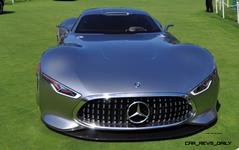
Tom Burkart is the founder and managing editor of Car-Revs-Daily.com, an innovative and rapidly-expanding automotive news magazine.
He holds a Journalism JBA degree from the University of Wisconsin – Madison. Tom currently resides in Charleston, South Carolina with his two amazing dogs, Drake and Tank.
Mr. Burkart is available for all questions and concerns by email Tom(at)car-revs-daily.com.


